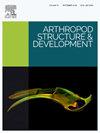Innervation of the subgenual organ in the stick insect Trachyaretaon echinatus: Neuroanatomical differences within Oriophasmata (Phasmatodea)
IF 1.3
3区 农林科学
Q2 ENTOMOLOGY
引用次数: 0
Abstract
Neuronal features including the nerve pattern are relatively conserved during evolution and are therefore useful for comparative studies. In stick insects (Phasmatodea), neuronal elements are rarely analysed for different groups. As the morphology of this group is characterised by convergent phenotypes, traits of the nervous system may provide additional information on phylogenetic relationships. Here, the innervation for a mechanosensory chordotonal organ, the subgenual organ in the proximal tibia, is documented by axonal tracing. For species of Neophasmatodea, previous studies showed an innervation for the subgenual organ with a single nerve branch in Occidophasmata (New World stick insects) compared to the Oriophasmata (Old World stick insects) where two separate nerve branches occur at the subgenual organ. Here, the innervation pattern is analysed in Trachyaretaon echinatus (Heteropterygidae: Obriminae), as Heteropterygidae are the sister-group to the remaining Oriophasmata. This species was chosen as representative of Heteropterygidae to test for a homogenous and thus likely conserved nerve pattern within Oriophasmata. The innervation of the subgenual organ shows a single nerve branch. Therefore, different innervation patterns occur within Oriophasmata. The innervation with one single nerve documented for T. echinatus is discussed as potentially plesiomorphic for Neophasmatodea.
竹节虫棘突的亚属器官神经支配:棘突目神经解剖学上的差异
包括神经模式在内的神经元特征在进化过程中相对保守,因此对比较研究有用。在竹节虫(Phasmatodea)中,很少对不同群体的神经元成分进行分析。由于这一群体的形态特征是趋同表型,神经系统的特征可能为系统发育关系提供额外的信息。在这里,神经支配的机械感觉脊索器官,亚属器官在胫骨近端,被记录轴突示踪。对于Neophasmatodea的物种,先前的研究表明,在Occidophasmata(新世界竹节虫)中,亚属器官的神经支配只有一个神经分支,而在Oriophasmata(旧世界竹节虫)中,亚属器官有两个独立的神经分支。在这里,我们分析了棘尾蝶的神经支配模式,因为棘尾蝶科是其余Oriophasmata的姐妹类群。该物种被选为异翅蝶科的代表,以测试在Oriophasmata内的同质性,因此可能是保守的神经模式。亚属器官的神经支配表现为单一的神经分支。因此,棉孔内存在不同的神经支配模式。棘棘棘虫的单神经支配被认为是新棘虫的潜在多形神经支配。
本文章由计算机程序翻译,如有差异,请以英文原文为准。
求助全文
约1分钟内获得全文
求助全文
来源期刊
CiteScore
3.50
自引率
10.00%
发文量
54
审稿时长
60 days
期刊介绍:
Arthropod Structure & Development is a Journal of Arthropod Structural Biology, Development, and Functional Morphology; it considers manuscripts that deal with micro- and neuroanatomy, development, biomechanics, organogenesis in particular under comparative and evolutionary aspects but not merely taxonomic papers. The aim of the journal is to publish papers in the areas of functional and comparative anatomy and development, with an emphasis on the role of cellular organization in organ function. The journal will also publish papers on organogenisis, embryonic and postembryonic development, and organ or tissue regeneration and repair. Manuscripts dealing with comparative and evolutionary aspects of microanatomy and development are encouraged.

 求助内容:
求助内容: 应助结果提醒方式:
应助结果提醒方式:


